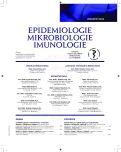Epidemiology and risk factors in legionellosis
Authors:
J. Povová 1; R. Zlámalová 1; A. Hozák 1; I. Martinková 2; M. Matějková 1; V. Janout 1
Authors‘ workplace:
Ústav epidemiologie a ochrany veřejného zdraví, Lékařská fakulta, Ostravská univerzita
1; Krajská hygienická stanice Moravskoslezského kraje, Ostrava
2
Published in:
Epidemiol. Mikrobiol. Imunol. 63, 2014, č. 4, s. 285-288
Category:
Review articles, original papers, case report
Overview
Legionella was discovered in the first half of the 20th century. The main representative of the genus is the bacterial species Legionella pneumophila. Legionella can cause a mild disease with fever but also severe to fatal pneumonia. At highest risk are individuals with an underlying disease, immunosuppressed patients or individuals exposed to other risk factors (e.g. users of addictive substances). Information on the etiolo-gy and epidemiology of legionellosis is presented. Selected risk factors are described as well as preventive measures to be taken in water supply and cooling systems. In conclusion, emphasis is placed on the prevention.
Keywords:
legionellosis – epidemiology – ecology – prevention – high-risk systems
Sources
1. Abdel-Nour M, Duncan C, Low DE, et al. Biofilms: the stronghold of Legionella pneumophila. International Journal of Molecular Science, 2013;14(11):21660–75.
2. Asghari FB, Nikaeen M, Hatamzadeh M, et al. Surveillance of Legionella species in hospital water systems: the significance of detection method for environmental surveillance data. Journal of Water & Health, 2013;11(4):713.
3. Bartram J. Legionella and the prevention of legionellosis [online]. 1. vyd. Switzerland: World Health Organization, 2007 [cit. 2014-03-20]. ISBN 92 4 156297 8. Dostupné z: http://www.who.int/water_sanitation_health/emerging/legionella.pdf.
4. Beneš J, et al. Infekční lékařství. 1. vyd. Praha: Galén, 2009, s. 651. ISBN 978-80-7262-644-1.
5. Carratalà J, Garcia-Vidal C. An update on Legionella. Current Opinion in Infectious Diseases, 2010;23(2):152–157.
6. Česká republika. Evropské směrnice pro kontrolu a prevenci legionářské nemoci. In: 2006. Dostupné z: http://www.unichem.cz/download/EU_Smernice_070123.pdf.7. Donohue MJ, O’Connell K, Vesper SJ, et al. Widespread molecular detection of Legionella pneumophila Serogroup 1 in cold water taps across the United States. Environmental Science & Technology, 2014;48(6):3145–52.
8. Dostál V, et al. Infektologie. 1. vydání Praha: Karolinum, 2004, s. 338. ISBN 80-246-0749-2.
9. European Working Groupe for Legionella Infection (EWGLI) [online]. dostupné z www: http://www.ewgli.org/+http://ecdc.europa.eu/en/activities/surveillance/ELDSNet/Pages/Description_of_the_network.aspx.
10. Euser SM, de Jong S, Bruin JP et al. Legionnaires’ disease associated with a car wash installation. The Lancet, 2013;382(9910):2114.
11. Global Alert and Response (GAR): Real time alert. World Health Organization [online]. 2012 [cit. 2014-03-20]. Dostupné z: http://www.who.int/csr/don/archive/disease/legionellosis/en/.
12. Göpfertová D, Pazdiora P, Dáňová J. Epidemiologie (obecná a speciální epidemiologie infekčních nemocí). 1. vydání Praha: Karolinum, 2006, s. 300, ISBN 80-246-1232-1.
13. Greenwood D. Lékařská mikrobiologie: Přehled infekčních onemocnění: patogenita, imunita, laboratorní diagnostika a epidemiologie. Praha: Grada Publishing s r. o., 1999, s. 690. ISBN 80-7169-365-0.
14. Grúas C, Llambi S, Arruga MV. Detection of Legionella spp. and Legionella pneumophila in water samples of Spain by specific real-time PCR. Archives of Microbiology, 2014;196(1):63–71.
15. Heuner K, Swanson M. Legionella Molecular Microbiology. Norfolk, UK: Caister Academic Press, 2008, s. 250. ISBN 978-1-904455-26-1.
16. Jørgensen CS, Uldum SA, Elverdal PL. Application of a lateral flow test as an additional serological tool for diagnosis of Legionella infectio-ns. Journal of Microbiological Methods, 2014;96:12–15.
17. Position Statement. Centers for Disease Control and Prevention [online]. Atlanta, 2006 [cit. 2014-03-20]. Dostupné z: http://www.cdc.gov/legionella/legionella_CSTE_statement.htm.
18. Q&A. European Center for Disease Prevention and Control [online]. 2005 [cit. 2014- 03-20]. Dostupné z: http://ecdc.europa.eu/en/healthtopics/legionnaires_disease/basic_facts/Pages/QA.aspx
19. Státní zdravotní ústav: EPIDAT [on line]. Dostupné z www: http://www.szu.cz/publikace/data/vybrane-infekcni-nemoci-v-cr-v-letech-2003-2012-absolutne.
20. Votava M., et al. Lékařská mikrobiologie speciální. Dotisk. Brno: Neptun 2006, s. 495. ISBN 80-902896-6-5.
Labels
Hygiene and epidemiology Medical virology Clinical microbiologyArticle was published in
Epidemiology, Microbiology, Immunology

2014 Issue 4
Most read in this issue
- Prevalence study of nosocomial infections in university hospitals in the Czech Republic
- Seroprevalence of Anaplasma phagocytophilum in patients with suspected Lyme borreliosis
- Current situation in clinical trials with vaccines in the Czech Republic
-
Infections caused by non-Typhi serovars of Salmonella at the
Infectious Diseases Clinic of the University Hospital Brno in 2011–2013
